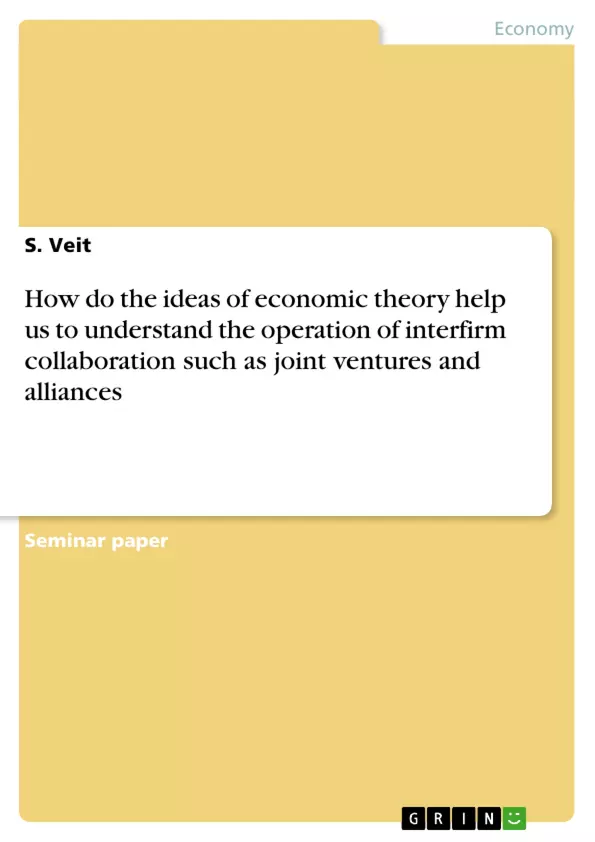Since the 1980s joint ventures and strategic alliances have enjoyed great popularity with firms, mainly in new and technology-intensive industries (Grabher p.12). Where two competitive firms work together to achieve a common purpose, this cooperation is named interfirm collaboration. Such collaborations are famous for their aim to avoid negative effects of competition or to benefit from the transfer of information and skills. The fact that competitors decide to establish a quasi - contractual relationship rather than to compete is discussed by various economic theories. The following implementations deal with these economic approaches. At first circumstances that lead firms to collusive behavior are analyzed, followed by specifying game theory as a suitable model to explain why firms decide to collaborate. The third part of this paper analyses various kinds of contractual relationships between collaborating firms, leading to a brief outline on stability of collaboration and problems appearing in such relationships.
Inhaltsverzeichnis (Table of Contents)
- Introduction
- Reasons for interfirm collaboration
- Risk and uncertainty
- Poor profitability
- Market variables
- Game theory
- The prisoner's dilemma
- Translation into a business situation
- The iterated game
- Forms of interfirm collaboration
- Trade associations
- Joint ventures
- Strategic alliance
- Cartels
- Price leadership
- Interfirm collaboration's mode of operation
- An economic model
- Collusive contracts
- Stability of collusive agreements
Zielsetzung und Themenschwerpunkte (Objectives and Key Themes)
This paper examines the economic theories that explain interfirm collaboration, particularly focusing on joint ventures and strategic alliances. It aims to understand how economic principles contribute to understanding the operation of these collaborations.
- Economic factors driving interfirm collaboration
- Game theory as a model for explaining collaborative decisions
- Types and characteristics of interfirm collaborations
- The dynamics of collaboration and its potential for stability
- The role of economic models in understanding collaborative behaviour
Zusammenfassung der Kapitel (Chapter Summaries)
The introduction outlines the increasing popularity of interfirm collaborations, particularly in new and technology-intensive industries. It highlights the collaborative nature of these ventures and the economic theories that explain them.
The second chapter explores the key economic reasons behind interfirm collaboration, examining factors like risk, uncertainty, profitability, and market variables. It provides a theoretical framework for understanding the motivations behind these collaborations.
Chapter three dives into the realm of game theory and how it serves as a model for explaining why firms choose to collaborate rather than compete. It explores the concept of the prisoner's dilemma and its application to business situations, emphasizing the iterated game.
The fourth chapter delves into different forms of interfirm collaboration, including trade associations, joint ventures, strategic alliances, cartels, and price leadership. It provides a nuanced understanding of the different types of collaborations and their characteristics.
The fifth chapter examines how interfirm collaboration operates from an economic perspective, introducing an economic model and exploring the concept of collusive contracts.
Chapter six focuses on the stability of collusive agreements, analyzing the challenges and factors that affect the longevity of interfirm collaborations.
Schlüsselwörter (Keywords)
The key themes and concepts explored in this work include interfirm collaboration, joint ventures, strategic alliances, game theory, prisoner's dilemma, iterated game, economic models, collusive agreements, and stability of collaboration.
- Citar trabajo
- S. Veit (Autor), 2004, How do the ideas of economic theory help us to understand the operation of interfirm collaboration such as joint ventures and alliances, Múnich, GRIN Verlag, https://www.grin.com/document/37002



